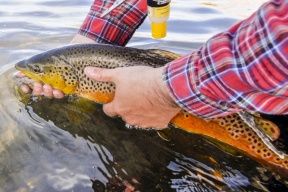
The September Solstice or fall equinox marks the moment the Sun crosses the celestial equator – the imaginary line in the sky above the Earth’s equator – from north to south and vice versa in March. While the March date is important, the fall solstice marks the true end of summer and the beginning of autumn.
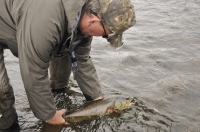
In mountain country the night time temperatures start feeling like autumn in early August but often the warm weather of summer can drag deeply into September. The bugs of summer start to wain when the weather is too nice for an extended period. Mayflies and other aquatic insects don’t use our calendar. Neither do trout. Yet there is almost always a dramatic change in weather prior to or immediately following the September equinox. We witnessed this dramatic change this past week. Our guide reservations were full and when the weather turned bad we expected some cancellations. It didn’t happen. All of our clients bundled up and went fishing. They were all happy they went.
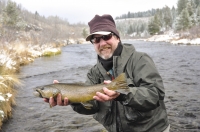
There is usually a period of very uncomfortable weather during the change. Windy weather coupled with rain, snow and sleet is not unusual. Such conditions make it tough for visiting anglers but fishing can be very good if you can brave the elements. Some aquatic creatures like Baetis mayflies actually thrive during adverse weather. The nastier the weather the more these cute little mayflies love it. They usually don’t get moving until later in the day if it is cold and wet. Don’t make the mistake of getting impatient. You won’t normally need to get on the water until early afternoon.
Along with aquatic insects, the September equinox has a dramatic impact on all of the creatures of our area. Elk and moose start getting their sexual motors revved up early in September but their hormones don’t really kick in until the autumn change. It’s always a plus to fish the Ranch or the park to hear the bugle of bulls in the distance. Other autumn sounds include honking, quacking and trumpeting from the variety of ducks, geese, swans, sandhill cranes and other waterfowl as the flock together prior to their migration.
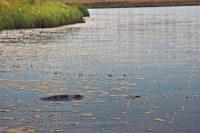
My favorite sound of autumn is the gulp of a big trout. The big ones can be hard to see as they rise soft and easy. It can be very difficult to distinguish the rise of a large trout to the untrained eye but there is no mistaken the sound. I have found many a trout hidden against an exposed weed bed simply from the sound.
Other mayflies and some caddisflies extend deep into September but while Mahogany Duns, Callibaetis, and Tricos are winding down, Baetis are winding up. The best hatches usually occur in October and can extend well into November. Commonly called Blue Winged Olives, there are actually several species of Baetis. The most common are those multi-brood species that also emerge in the spring. These two-tailed mayflies can be matched with size 18 – 20 hooks. You’ll need some emerger, cripple and dun imitations. Spinners are not normally a factor as they usually crawl under the surface to oviposit their eggs.
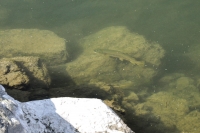
All of our rivers have good hatches of BWOs. You’ll find the best activity on the slower, quiet sections of the water. You can also find dry fly action with some large flies. Our green drake and grey drakes hatches occur in June on the Henry’s Fork. Other rivers like the Lamar and Slough Creek have a decent green drake hatch in late September and October. These are actually different species most likely Drunella coloradensis. You’ll also find a respectable gray drake hatch on the upper Teton River. These also might be a different bug than our Henry’s Fork gray drake as they are a bit larger and they hatch in the fall instead of early summer. At any rate these large mayflies can produce some great early autumn dry fly fishing.
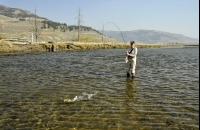
Just because the weather gets cold, don’t put away your hopper patterns. While frost takes a toll on hoppers, many of them survive well into October especially if we get a week or so of Indian summer. Hoppers are still around but most of them are over the hill and are actually more likely to end up in the water than when they are at their peak during the warm days of summer.
Most anglers agree that the best time to catch a monster trout is in the autumn using a streamer. I don’t like heavily weighted streamers. Rather, I like to use a section of sinking leader to help get the fly down. You don’t need to be down deep. You should experiment with different retrieves. Simply swinging the fly steelhead style will also take large trout.
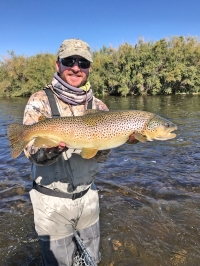
The most reliable way to catch autumn trout is with nymphs. No matter what the weather, trout will be feeding on nymphs. My least favorite way to fish nymphs is with a bobber but sometimes it is the only viable option. My preference is to high stick with a tight line. Another good option is to go with a dry/dropper. Small nymphs size 14 or smaller will normally outperform larger patterns.
No matter where you fish or what method you want to pursue some of our best fishing is just ahead. Make sure to bring your raincoat and a fleece jacket.